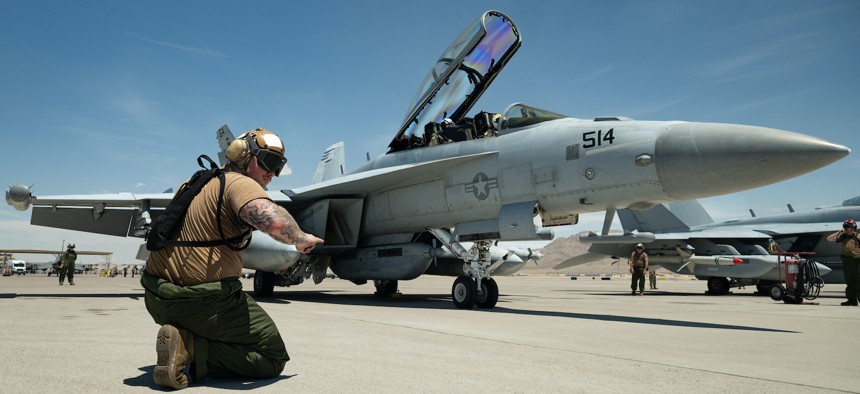
U.S. Navy Aviation Structural Mechanic Petty Officer 3rd Class Tyler Ritchie assigned to the Electronic Attack Squadron (VAQ) 138, Naval Air Station Whidbey Island, Washington, prepares an EA-18G Growler for a Red Flag 23-3 mission at Nellis Air Force Base, Nevada, July 18, 2023. U.S. Air Force / William R. Lewis
More tankers, E-7s, and better comms: lessons from Air Force’s Red Flag
The exercise featured U.S. Navy Carrier Strike Group Carl Vinson.
The latest iteration of the U.S. Air Force’s Red Flag wargame revealed some kinks to be worked out before the service can fully interoperate with the U.S. Navy in the Indo-Pacific region.
The air combat exercise, which ran from July 17 to August 4, started at Nellis Air Force Base and extended hundreds of miles off the California coast. It included a Navy carrier strike group—and that was useful, said Lt. Col. Andrew Stevens, deputy commander of the 414th Combat Training Squadron during Red Flag 23-3.
“What we learned from it, what we can improve—that's all about coordination between the operational [command and control] on the Navy side and going through down to get that coordinated list of requirements to the tactical operator on the Air Force side so that we can layer in timing, coordinated effects, as well as basically sorting out the targeting so that we can be as efficient as possible with our low-inventory, high-value weapons systems,” Stevens said.
However, the Air Force still needs more training before it can fully interoperate with the Navy, he said.
“Right now, I think that we're only education and training away from being functional, if not optimized. So I think that whenever we were talking in terms of the plan, everybody kind of understands exactly what the other agencies need and want to do, we just need to see it more in training to smooth out some of those little wrinkles,” Stevens said.
A Pacific fight will also require better-equipped tankers, Stevens said.
“I'd say the first critical capability that I would think of is our tanker roster, so how many tankers we have, how reliable they are, and I would want to increase the amount of comms-suite capability on those tankers to build out long-range bridges for our line-of-sight comms to enable redundancy to our space-enabled comms,” Stevens told Defense One.
Another must-have: multiple survivable next-gen command-and-control aircraft—i.e., the E-7 Wedgetail currently in development by Boeing, Stevens said.
“I would like to see a constellation of E-7s,” Stevens said. “I not only want a single E-7 out in the [battle]space—I want three, minimally.”
Pentagon officials have said they need E-7s to handle airborne domain awareness and to maintain air superiority in the Pacific region as they retire E-3 Sentry AWACS-carrying radar planes. Lawmakers who agree have been pushing the service to accelerate the program, which is currently slated to deliver the first test E-7 in 2027.
Another large part of the exercise was recreating enemy threats for pilots to train against. Nellis reactivated its F-35 aggressor squadron last year, and in May stood up a new F-16 aggressor squadron to replicate enemy threats. Both aggressor squadrons participated in Red Flag—using tactics based on intel on adversary capabilities to accurately recreate “what’s a realistic and relevant threat,” Stevens said.
While he couldn’t detail the exact threats aggressor squadrons recreated, Stevens said they were “the most technologically advanced adversary assets that we project potentially having to engage depending on our civilian leadership's request.”
They also trained against “aggressor naval surface vessels”—aka U.S. vessels pretending to be Chinese ships. “So that helps us practice those [tactics, techniques, and procedures] for countering advanced surface capabilities over the water,” Stevens said.
Stevens said future iterations of Red Flag will continue to feature its sister service.
“I can tell you definitively that our efforts are to continue the Navy integration and over-water counter maritime TTPs for the foreseeable future in Red Flag,” Stevens said.


